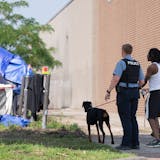If a bank branch closes, they take a crowbar to the logo. If a Burger King shutters, no one petitions the city to declare the sign a landmark. But when a neighborhood movie theater closes, there’s an unspoken rule: Don’t you dare touch that marquee.
Neighborhood theaters have a unique spot in the urban landscape. To the locals, they’re often one of the few artifacts of a bygone era — especially when a marquee has been burning holes in the night since the days of FDR.
If you’ve been through Edina lately, you may have noticed that the eponymous theater has reopened. The marquee is now bright red. You hope it stays in the black.
Neighborhood movie theaters have been hammered for decades by familiar foes — TV, home video, massive multiplexes that offer 16 screens and modern comforts. Add COVID, and it’s a miracle any small movie houses survived. The Edina was closed for a while, and few thought it would return. But it has.
Reopening the theater almost seems audacious. And generous: It’s in prime commercial territory, after all. They could’ve converted it to offices and boutiques, and kept the marquee as a quaint relic that gave you all the nostalgia feelings.
It certainly wouldn’t be the first time the theater left and the sign stayed.
The old Lyndale theater (2932 Lyndale Av. S., Mpls.) hasn’t shown movies since 1954. Built in 1915, it’s spent more of its life not being a movie house than it spent showing films. But it still looks like a movie theater, mostly due to the marquee.
The Wayzata (619 Lake Street E., Wayzata) was built in 1932, designed by Liebenberg and Kaplan, the same firm that did the Edina, the Uptown, the Varsity and other Minnesota landmarks. It closed in 1985, the building converted to commercial purposes, but you’d better believe they saved the landmark sign.

